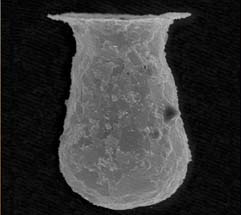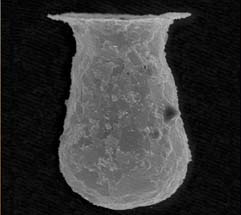

Scanning electron micrograph of the test of Difflugia mulanensis nov. spec. from Lake Mulan.
In cooperation with a German colleague, researchers from the CAS Institute of Hydrobiology (IHB) discovered a new species of the mono-cellular organism,
Difflugia mulanensis nov. spec. Their work was reported as a cover story by the fourth issue of the European Journal of Protistology.
Difflugia is a morphologically diverse genus of lobose testate amoeba, an important and abundant component of planktons in aquatic ecosystems. Its species have been reported from many countries in the world and are found widely living in various freshwater habitats.
The new species
Difflugia mulanensis nov. spec. was brought to light from the Lake Mulan in Central China's Hubei Province. The researchers made a detailed observation of its morphology and biometry with light and scanning electron microscopy. After a taxonomic analysis in comparison with its eight cousins in the same genus, they reached a conclusion that it is a new species in protista, a kingdom of eukaryotes featuring more or less shapelessness and movement by means of extensions known as pseudopodia ("false feet").
Under the tutelage of Prof. SHEN Yunfen, a CAS member from IHB, YANG Jun, lead author of the article titled "
Difflugia mulanensis nov. spec., a freshwater testate amoeba from Lake Mulan, China," made taxonomic identification of more than 300 species in the freshwater testate amoebae during his postgraduate studies. In the process of his work, he challenged the traditional view that there is no pattern of geographic distribution for such organisms by putting forward a new idea, claiming there is a pattern in the distribution and diversity of the testate amoebae and the latter are closely related to their local environmental factors and macro-environments.
His work reveals that the ups and downs in a plankton population may serve as an indicator for monitoring the environmental changes, in particular climatic changes. Yang's article has received much attention from the S&T community. In addition, his study on testate amoebae was reported in many press media in China, including
Science Times, Hubei Daily and
Changjiang Daily.
On the July 7 Yang's study on
Difflugia biwae Kawamura was reported in an important and influential Japanese newspaper
Mainichi Shimbun. At the very beginning of the 20th century, living specimens of the
D. biwae were sampled from the lakewater of Japan's largest freshwater Lake Biwa on the Island of Honshu. In the subsequent 80 years since then,
D. biwae had been regarded as the only endemic species in Japan and after the 1980s, it has been reported the plankton became extinct due to the lake water's eutrophication and environmental degeneration in the Lake Biwa itself and its periphery. Yang's new findings of the living specimen of D. biwae from Central China's Lake Mulan provoked a lot of interest of scientists and the general public in Japan.
In July, Dr. Yang was honored as the only Chinese among five speakers with "the best oral presentations and poster for young scientists" at the 12th International Conference of Protistology. An authoritative scholar in the field, Prof. Wilhelm Foissner praised Yang Jun in his invited speech at the Conference by introducing the young Chinese scientist's work at the meeting. According to him, Yang's work should be one of the Chinese research feats mentioned by his speech in the field of protozoan research of this country.






